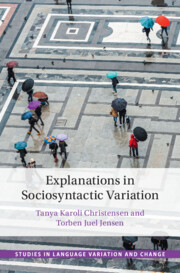Book contents
- Explanations in Sociosyntactic Variation
- Studies in Language Variation and Change
- Explanations in Sociosyntactic Variation
- Copyright page
- Contents
- Figures
- Tables
- Contributors
- Series Editor’s Preface
- Acknowledgements
- Introduction: Analysing and Explaining Syntactic Variation
- 1 Comparing Syntactic Variables
- 2 Mapping Syntax and the Sociolinguistic Monitor
- 3 A Columbia School Perspective on Explanation in Morphosyntactic Variation
- 4 On the Inevitability of Social Meaning and Ideology in Accounts of Syntactic Change: Evidence from Pronoun Competition in Netherlandic Dutch
- 5 The Predictability of Social Stratification of Syntactic Variants
- 6 When Variants Lack Semantic Equivalence: Adverbial Subclause Word Order
- Index
- References
4 - On the Inevitability of Social Meaning and Ideology in Accounts of Syntactic Change: Evidence from Pronoun Competition in Netherlandic Dutch
Published online by Cambridge University Press: 06 January 2022
- Explanations in Sociosyntactic Variation
- Studies in Language Variation and Change
- Explanations in Sociosyntactic Variation
- Copyright page
- Contents
- Figures
- Tables
- Contributors
- Series Editor’s Preface
- Acknowledgements
- Introduction: Analysing and Explaining Syntactic Variation
- 1 Comparing Syntactic Variables
- 2 Mapping Syntax and the Sociolinguistic Monitor
- 3 A Columbia School Perspective on Explanation in Morphosyntactic Variation
- 4 On the Inevitability of Social Meaning and Ideology in Accounts of Syntactic Change: Evidence from Pronoun Competition in Netherlandic Dutch
- 5 The Predictability of Social Stratification of Syntactic Variants
- 6 When Variants Lack Semantic Equivalence: Adverbial Subclause Word Order
- Index
- References
Summary
In this chapter we investigate the role of socio-psychological motivations in accounts of grammatical change. Laboratory and corpus evidence is presented to substantiate the impact of dynamic prestige meanings (associated with non-posh media cool) on the diffusion of the object pronoun hun 'them' as a subject in Netherlandic Dutch. In a speaker evaluation experiment, 185 listener-judges rated speech stimuli with standard and non-standard pronouns on pictures which were the best instantiations, according to a preceding norming task, of the evaluation dimensions old prestige (superiority), new prestige (dynamism), and disapproval. While subject-hun was found to be significantly less superior than the standard pronoun, it was perceived to be no less dynamic. The impact of this dynamic prestige meaning was further investigated on the basis of a dataset of tweets. Regression analysis demonstrated that the preference for hun could be adequately predicted on the basis of production proxies of hun’s social meaning. Taken together, all the available data suggest that the social meaning of hun is a pivotal determinant of its diffusion, viz. its use as a consciously deployed 'stylizer', but also the internal conditioning of its non-conscious use as a pronoun alternative.
Keywords
- Type
- Chapter
- Information
- Explanations in Sociosyntactic Variation , pp. 120 - 143Publisher: Cambridge University PressPrint publication year: 2022
References
- 2
- Cited by



